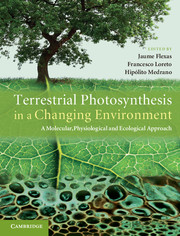 Terrestrial Photosynthesis in a Changing Environment
Terrestrial Photosynthesis in a Changing Environment Book contents
- Frontmatter
- Contents
- List of contributors
- Preface
- Acknowledgements
- List of abbreviations
- 1 Terrestrial photosynthesis in a changing environment
- Part I Photosynthesis
- 2 Biochemistry and photochemistry of terrestrial photosynthesis: a synopsis
- 3 Photosynthetic regulation
- 4 Interactions between photosynthesis and day respiration
- 5 The ecophysiology and global biology of C4 photosynthesis
- 6 Ecophysiology of CAM photosynthesis
- 7 Special photosynthetic adaptations
- 8 Models of photosynthesis
- Part II Measuring photosynthesis
- Part III Photosynthetic response to single environmental factors
- Part IV Photosynthesis in time
- Part V Photosynthesis in space
- Part VI Photosynthesis in a global context
- References
- Index
8 - Models of photosynthesis
Published online by Cambridge University Press: 05 March 2013
- Frontmatter
- Contents
- List of contributors
- Preface
- Acknowledgements
- List of abbreviations
- 1 Terrestrial photosynthesis in a changing environment
- Part I Photosynthesis
- 2 Biochemistry and photochemistry of terrestrial photosynthesis: a synopsis
- 3 Photosynthetic regulation
- 4 Interactions between photosynthesis and day respiration
- 5 The ecophysiology and global biology of C4 photosynthesis
- 6 Ecophysiology of CAM photosynthesis
- 7 Special photosynthetic adaptations
- 8 Models of photosynthesis
- Part II Measuring photosynthesis
- Part III Photosynthetic response to single environmental factors
- Part IV Photosynthesis in time
- Part V Photosynthesis in space
- Part VI Photosynthesis in a global context
- References
- Index
Summary
Introduction: Why Use Photosynthesis Models?
One of the goals of science is prediction, and quantitative predictions are based on models. Models vary in the degree to which they represent underlying processes from purely empirical regression models to those that represent physical, chemical and biological processes (mechanistic or process models). Mechanistic models tend to be more complex and are empirical at the level of the processes they include (parameters). Mechanistic models can also test whether our current knowledge is sufficient to explain experimental data and generate and test new hypotheses that lead to progress in understanding. Prediction of carbon fixation of vegetation by photosynthesis in a changing environment is important to assess ecological matters like global climate change or agronomic issues such as yield improvements. Models of photosynthesis play a key role in predicting primary production of vegetation and crop yield in a variable climate. They have also been implemented in weather-forecast models, improving predictions of humidity and temperature anywhere from 5 to 10% (Goudarzi, 2006). The level of detail of these models is largely dependent upon the objectives of the studies for which the models were designed. Questions concerning effects of environmental conditions on the process of photosynthesis itself can be addressed using single-leaf photosynthesis models. Vegetation canopies are composed of leaves and of support structures (stems, trunks) that represent a greater challenge for predicting photosynthesis. The simplest canopy models invoke the so-called ‘big-leaf’ assumption, and may include various simple approximations for structural and physiological complexity (e.g., Sellers et al., 1992). More complicated models include multiple canopy layers each with different properties (e.g., Medlyn et al., 2005). Layered models require detailed knowledge of the variation in parameters throughout the canopy depending on position and age, as well as knowledge of the distribution of foliage and environmental variables in the canopy. The objective of modelling is double. On one hand, models can be used in a bottom-up approach to predict photosynthesis variations in response to environmental variables. To do so, it is needed to first parameterise the photosynthesis model itself, obtaining representative values of the maximum carboxylation efficiency (Vc,max), the maximum rate of electron transport (Jmax) and the capacity for TPU (sections 8.3–8.6).
- Type
- Chapter
- Information
- Terrestrial Photosynthesis in a Changing EnvironmentA Molecular, Physiological, and Ecological Approach, pp. 98 - 112Publisher: Cambridge University PressPrint publication year: 2012
- 3
- Cited by


